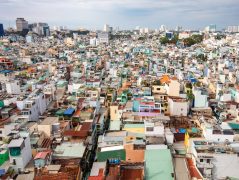
Ho Chi Minh City
Contents
1 Introduction2 Data and Facts3 Administration4 Economy5 Business Environment6 Infrastructure7 Technology8 ReferencesIntroduction
Ho Chi Minh City (HCMC) (previously known as Saigon) is the most populated city of Vietnam. It has a population of around 9 million as of 2019. It gets its former name by the Saigon River that it surrounds in the southeast of Vietnam. The total area covered is 2,061 square kilometers, and was once the capital of Vietnam. However, it is considered the financial capital of Vietnam.
The city has the popular Ho Chi Minh stock exchange, which is the largest stock exchange in the country. HCMC is also the headquarters for various major banks and companies. The residents are known traditionally as Saigonese and the city has the busiest airport in Vietnam as well.
Data and Facts
- HCMC is located 1,760 kilometers south of Hanoi, with an elevation of 19 meters above sea level.
- It has a tropical climate with humidity ranging between 78-82%.
- The city has 2 major seasons – monsoon which lasts from May to November; and summer which lasts from December to April. Temperatures can go up to 40 degrees Celsius.
- The residents of Ho Chi Minh City include the ethnic Vietnamese known as Kinh (94%) and the ethnic Chinese (6%).
- The religions followed here are Mahayana Buddhism, Taoism, and Confucianism.
- Vietnam has the 2nd largest motorcycle usage after Taiwan, a majority of which is contributed by HCMC, approximately 7 million.
- The city is also growing as an education hub with 80 universities and colleges and a 400,000 student population.
Administration
The city is divided into 19 urban districts and 5 rural districts. It has a municipality for governance. There is also a people’s committee, which has a 13 member executive branch. The current chairman of this committee is Nguyen Thanh Phong. There is a people’s council as part of the legislative branch, which has 95 members. The current chairwoman there is Nguyen Thi Quyet Tam. The communist party has a council operating in the city, whose secretary is ranked the 2nd most powerful.
Economy
HCMC accounts for a large part of Vietnam’s economy, which includes 8.34% of the population, 20.2% of the GDP, 27.9% of the industrial output and 34.9% of the FDI, as in 2005. The total GDP was the US $181.49 billion and per capita the US $21167 as in 2018. The city’s GDP grew at 9.5% in 2018.
The city’s media is the most developed in Vietnam, with 7 daily newspapers which include Sai Gon Giai Phong as the principal one and has various editions of investment, finance, sports, etc. The city’s General library has over 1.5 million books. The National Vietnam Television (NTV) broadcasts 24/7 on 7 different channels. Many international TV channels are provided through 2 cable networks SCTV and HTVC with over one million subscribers.
Tourist attractions here are mainly from the French dynasty and Vietnam War such as the French colonies and American style boulevards. Popular among them are the Reunification Palace, City Hall, Municipal Theatre, City Post Office. There are also various museums that hold artifacts from the war period, colonization period and speak volumes about the city’s past.
HCMC accounts for over 20% of the GDP of Vietnam and is Asia’s 50th most expensive city to live in. The city thrives on a cash economy. The largest stock exchange of the country is situated here, it is the finance capital and major hub in Asia. The healthcare system is quite developed with over 100 government-owned hospitals and many private clinics as well. The Cho Ray hospital is a 1400 bedded hospital, which has been upgraded by the Japanese.
Business Environment
The economy is comprised of industries ranging from mining, seafood processing, agriculture, and construction to tourism, finance, industry, trade. The public sector marks 33.3% of the economy, private sector 4.6% and the remaining is occupied by foreign investment. Structure-wise, the service sector accounts for 51.1% of the industry, construction accounts for 47.7% and forestry, agriculture accounts for just 1.2%. There is a high tech IT park known as Quang Trung Software Park of 15 kilometers.
Infrastructure
The city has Vietnam’s largest Tan Son Nhat International airport, which transports over 15.5 million passengers annually. HCMC is a major terminal for most trains operating in the country. There is also a commercial and passenger port. The city is well connected by metro and bus service. Also, the North-South Expressway connects HCC with other major cities.
Technology
The city has an IT park which is 15 kilometers from downtown Ho Chi Minh City. The park has many software companies and dotcom companies. There is also a training school in IT. Investors here are provided with facilities such as residencies and high-speed internet. It is a major outsourcing center for software solutions in the country.
References
https://en.wikipedia.org/wiki/Ho_Chi_Minh_City
https://www.ledgerinsights.com/vietnam-smart-city-blockchain-framework/
https://www.virgin.com/entrepreneur/worlds-best-start-hubs-ho-chi-minh-city-vietnam
https://open-for-business.org/ho-chi-minh-city
https://www.gso.gov.vn/default.aspx?tabid=512&idmid=5&ItemID=19279
https://www.lboro.ac.uk/gawc/world2018t.html
https://en.vietnamplus.vn/first-foreign-visitors-of-2020-arrive-in-hcm-city/166495.vnp
https://www.wdl.org/en/item/226/view/1/1/
https://www.bbc.co.uk/history/historic_figures/ho_chi_minh.shtml
 Metricsbeta
Metricsbeta